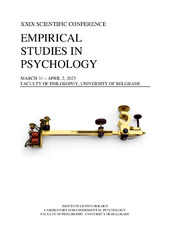| dc.creator | Grbić, Sanja | |
| dc.creator | Stanković, Biljana | |
| dc.date.accessioned | 2023-05-15T12:40:15Z | |
| dc.date.available | 2023-05-15T12:40:15Z | |
| dc.date.issued | 2023 | |
| dc.identifier.isbn | 978-86-6427-247-6 | |
| dc.identifier.uri | http://reff.f.bg.ac.rs/handle/123456789/4458 | |
| dc.description.abstract | The fundamental assumption of sociocultural psychologists studying narrative identity
development is that individual identity is co-constructed, i.e., a product of social relations.
Characteristics of this process of co-construction are, nevertheless, empirically underexplored,
and this gap is especially prominent in the studies of adolescent identity. The “Big story”
approach, dominant in the field, advocates individual interviews and the use of retrospective
data in order to examine already established identity positions. Alternatively, psychologists
observe participants’ interactions or experimentally manipulate them in order to quantify the
aspects of the storyteller’s self-narrative and to correlate them to the listener’s reactions. What
is missing are methodological tools that would enable researchers to examine qualitative
aspects of the process of adolescent identity co-construction during interaction. In the last 20
years, the “Small story” approach has emerged within narrative psychology and it focuses on
the microgenetic processes of identity development. These processes refer to the progressive
sedimentation of interactive sense-making through negotiation in which various identity
positions get tried out, resisted, or adopted. This paper builds on methodological resources
advanced by the “Small story” approach and further develops them, with the aim to offer a
methodological framework for analyzing identity co-construction. The framework entails three
levels of interaction analysis, each posing different analytical questions. The first level utilizes
resources of conversation analysis and focuses on the formal aspects of interaction in order to
answer how the participants achieve shared understanding and demonstrate affiliation. The
second level pertains to discourse analysis of strategies, demonstrating how participants
negotiate and which devices they use to impose their own morally defensible account. The third
level uses positioning analysis (supplemented by the ethnomethodological membership
categorization analysis), aimed at determining which identity positions are co-construed and
made available by the form of interaction and strategies employed. The practical application of
this framework will be demonstrated to show the usefulness of presented methodological tools
for sociocultural studies of identity exploration in adolescence, especially when these “Small
story” resources are combined with the “Big story” methodology. | sr |
| dc.language.iso | en | sr |
| dc.publisher | Beograd: Institut za psihologiju i Laboratorija za eksperimentalnu psihologiju Filozofskog Fakulteta Univerziteta u Beogradu | sr |
| dc.relation | 451-03-47/2023-01/200163 | sr |
| dc.rights | openAccess | sr |
| dc.rights.uri | https://creativecommons.org/licenses/by/4.0/ | |
| dc.source | Book of abstracts, XXIX Scientific Conference “Empirical Studies in Psychology”, Belgrade | sr |
| dc.subject | narrative psychology | sr |
| dc.subject | adolescent identity development | sr |
| dc.subject | peer interactions | sr |
| dc.subject | discourse analysis | sr |
| dc.subject | positioning analysis | sr |
| dc.title | How can we empirically explore adolescent identity co-construction? Discursive approach to positioning analysis as a methodological contribution to sociocultural psychology | sr |
| dc.type | conferenceObject | sr |
| dc.rights.license | BY | sr |
| dc.citation.rank | M34 | |
| dc.citation.spage | 72 | |
| dc.identifier.fulltext | http://reff.f.bg.ac.rs/bitstream/id/10960/EIP_2023_apstrakt.pdf | |
| dc.identifier.rcub | https://hdl.handle.net/21.15107/rcub_reff_4458 | |
| dc.type.version | publishedVersion | sr |

